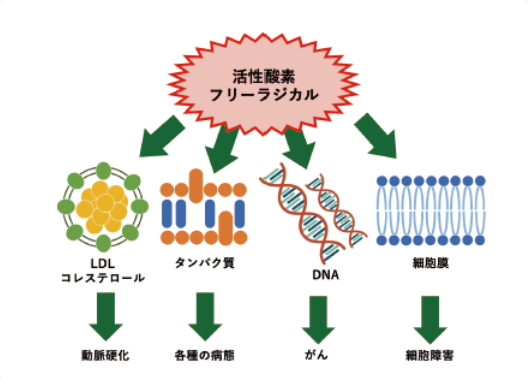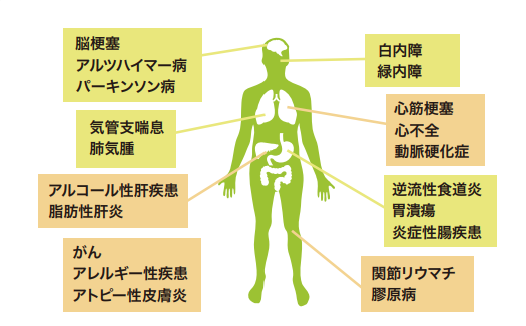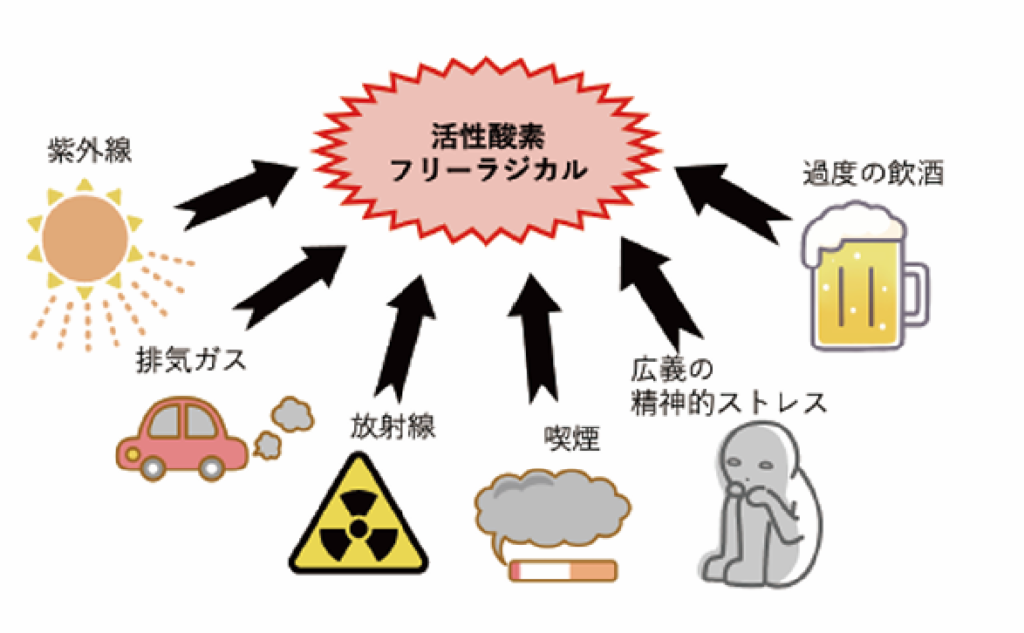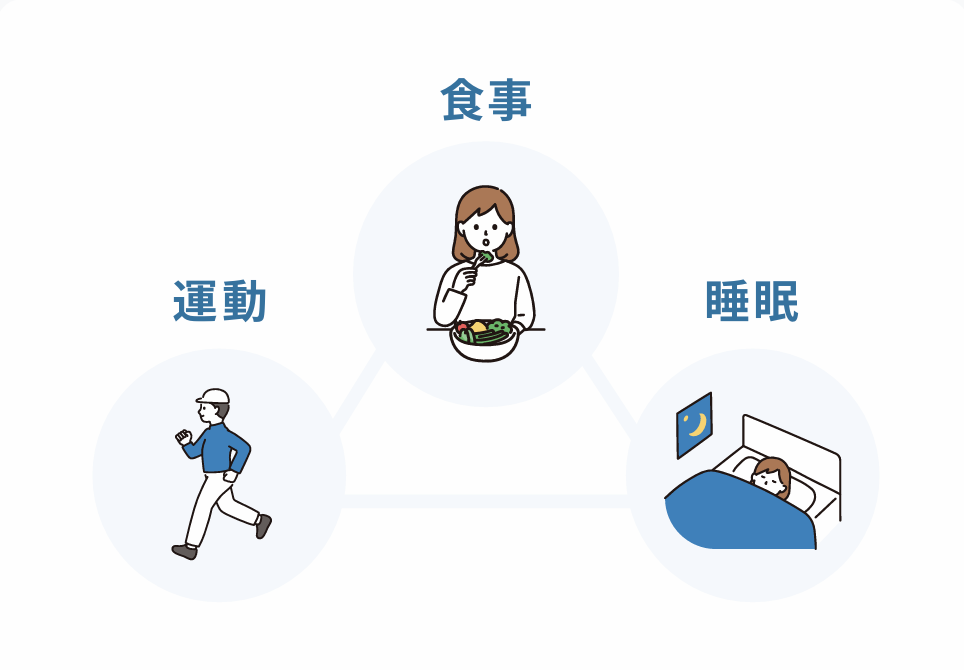Living organisms take in oxygen through respiration to produce the energy necessary for life activities. During this process, toxic byproducts known as "reactive oxygen species (ROS) and free radicals," which are more reactive than oxygen, are generated.
In other words, as long as we utilize oxygen to sustain life, these toxic substances will continue to be produced within our bodies. To manage this, living organisms have developed the ability to use this toxicity in a balanced way—as a weapon to eliminate invading bacteria and viruses, as well as stimulants related to reproduction and memory.


However, highly toxic reactive oxygen species (ROS) and free radicals can easily damage cell membranes, which are made of lipids.
This damage can lead to cellular injury and, in severe cases, cell death. DNA, enzymes, and LDL cholesterol can also be harmed, making it essential to control ROS and free radicals in the body. To combat this, the body is equipped with the ability to neutralize these toxic substances, known as antioxidant capacity. However, various factors encountered in daily life can disrupt the balance between antioxidant capacity and the presence of toxic substances, leading to a state where toxic substances are more prevalent in the body. This imbalance is referred to as "oxidative stress."
Changes in oxidative stress can be observed in the form of aging. Even among individuals of the same age, some appear youthful while others do not, potentially due to the significant impact of oxidative stress.
Oxidative stress occurs throughout the entire body and is therefore closely associated with the onset and progression of various diseases.
It is said that more than 100 diseases are related to oxidative stress. This extensive involvement suggests that oxidative stress plays a significant role not only in commonly known diseases—such as cancer, diabetes, cardiovascular diseases, Alzheimer’s disease, and Parkinson’s disease—but also in rare conditions, hard-to-treat diseases, and designated intractable diseases.


Reactive oxygen species (ROS) and free radicals are generated within the body not only due to external factors such as ultraviolet rays, radiation, air pollution like exhaust gases, but also due to lifestyle factors such as lack of exercise, stress, smoking, and excessive alcohol consumption, as well as infections or diseases caused by bacteria and other pathogens.
As a result, the production of ROS and free radicals varies depending on differences in living environments, lifestyle habits, and the presence of pre-existing medical conditions.
The body's natural antioxidant functions (antioxidant capacity) broadly serve three main roles.
・Suppresses the generation of reactive oxygen species (ROS) and free radicals.
・Rapidly removes toxic substances once they are generated.
・Repairs and regenerates DNA, lipids, and proteins damaged by ROS and free radicals.
This antioxidant capacity is said to peak in the 20s and gradually decline with age. When reactive oxygen species (ROS) and free radicals are actively produced due to living environments, lifestyle habits, or pre-existing conditions, the body utilizes its antioxidant functions to their fullest extent in an effort to eliminate the excessive toxins and maintain homeostasis. However, this ability is not absolute.
Prolonged exposure to external factors or sustained disruptions in lifestyle habits can accelerate the decline of antioxidant capacity, regardless of age. When the balance shifts in favor of ROS, the body can no longer sufficiently suppress their harmful effects, disrupting homeostatic functions. This imbalance can lead to the acceleration of aging processes and become a root cause of various diseases.

Since reactive oxygen species (ROS) and free radicals are produced due to lifestyle habits and external factors, revisiting and improving habits such as diet, exercise, sleep, and other aspects of daily life can help reduce their excessive production and prevent the exhaustion of the body's antioxidant functions.
Therefore, it is clear that revising lifestyle habits forms the foundation of antioxidation.
Balanced Diet
It is important to consume foods rich in vitamins and minerals in a well-balanced manner. Antioxidants can also be obtained from your diet.
Try to include as many different types of ingredients as possible in a balanced way. Appropriate calorie intake is also effective in preventing obesity, which can lead to excessive oxidative stress. Aim for meals that leave you feeling about 80% full.
Moderate Exercise
Oxidative stress and antioxidant capacity are said to increase depending on the intensity of exercise. While oxidative stress increases due to exercise, the overall increase in antioxidant capacity eventually offsets it.
Excessive production of reactive oxygen species (ROS) caused by intense exercise can damage tissues. Aim for moderate exercise. Engage in about 150 minutes of exercise per week, such as 30 minutes of walking or jogging five days a week.
Quality Sleep
Research shows that lack of sleep increases oxidative stress, especially in the intestines, where numerous gut bacteria play a critical role in immunity.
Adequate sleep can activate the body's repair functions and enhance antioxidant capacity. Aim for 7–8 hours of high-quality sleep per night.
Other Lifestyle Habits
Avoid smoking and excessive alcohol consumption, as they increase oxidative stress. Protect your skin and eyes from UV rays by using sunscreen and wearing hats or sunglasses.
The Causes of Aging: Oxidative Stress
Practical Lifestyle Tips: Basics of Exercise, Diet, and Sleep